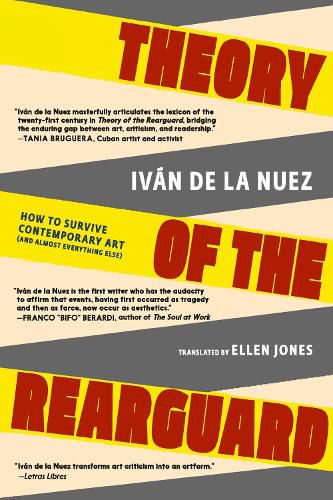Readings Newsletter
Become a Readings Member to make your shopping experience even easier.
Sign in or sign up for free!
You’re not far away from qualifying for FREE standard shipping within Australia
You’ve qualified for FREE standard shipping within Australia
The cart is loading…






Cuban art critic and curator Ivan de la Nuez returns with an ironic epitaph for contemporary art.
Art criticism that examines contemporary art in the 21st century in relationship to politics, iconography, and literature.
"Ivan de la Nuez transforms art criticism into an art form." -Letras Libres
Cuban art critic and curator Ivan de la Nuez returns with an ironic epitaph for contemporary art.
Art criticism that examines contemporary art in the 21st century in relationship to politics, iconography, and literature.
"Ivan de la Nuez transforms art criticism into an art form." -Letras Libres
Theory of the Rearguard examines how contemporary art is in tension with survival, rather than in relation to life. In the twentieth century, Peter B rger's Theory of the Avant-Garde was a cult book focused on the two main tasks that art demanded at the time- to break its representation and to destroy the barrier that separated it from life.
Forty years later, The Theory of the Rearguard is an ironic manifesto about contemporary art and its failures, even though Ivan de la Nuez does not waste his time mourning it or disguising it. He argues that our times are not characterized by the distance between art and life, but by a tension between art and survival, which is the continuation of life by any means necessary.
In the twenty-first century, Ivan de la Nuez examines art in relationship to politics, iconography, and literature. This austere and sharp book-in which Duchamp stumbles upon Lupe, the revolution upon the museum, Paul Virilio upon Joan Fontcuberta or Fukuyama upon Michael Jackson-wonders if contemporary art will ever end. Because if it were mortal-"just as mortal as everything it invokes or examines under its magnifying glass"-de la Nuez argues would be worth writing an epitaph for it as he has done in this sparkling book of art criticism.
$9.00 standard shipping within Australia
FREE standard shipping within Australia for orders over $100.00
Express & International shipping calculated at checkout
Cuban art critic and curator Ivan de la Nuez returns with an ironic epitaph for contemporary art.
Art criticism that examines contemporary art in the 21st century in relationship to politics, iconography, and literature.
"Ivan de la Nuez transforms art criticism into an art form." -Letras Libres
Cuban art critic and curator Ivan de la Nuez returns with an ironic epitaph for contemporary art.
Art criticism that examines contemporary art in the 21st century in relationship to politics, iconography, and literature.
"Ivan de la Nuez transforms art criticism into an art form." -Letras Libres
Theory of the Rearguard examines how contemporary art is in tension with survival, rather than in relation to life. In the twentieth century, Peter B rger's Theory of the Avant-Garde was a cult book focused on the two main tasks that art demanded at the time- to break its representation and to destroy the barrier that separated it from life.
Forty years later, The Theory of the Rearguard is an ironic manifesto about contemporary art and its failures, even though Ivan de la Nuez does not waste his time mourning it or disguising it. He argues that our times are not characterized by the distance between art and life, but by a tension between art and survival, which is the continuation of life by any means necessary.
In the twenty-first century, Ivan de la Nuez examines art in relationship to politics, iconography, and literature. This austere and sharp book-in which Duchamp stumbles upon Lupe, the revolution upon the museum, Paul Virilio upon Joan Fontcuberta or Fukuyama upon Michael Jackson-wonders if contemporary art will ever end. Because if it were mortal-"just as mortal as everything it invokes or examines under its magnifying glass"-de la Nuez argues would be worth writing an epitaph for it as he has done in this sparkling book of art criticism.